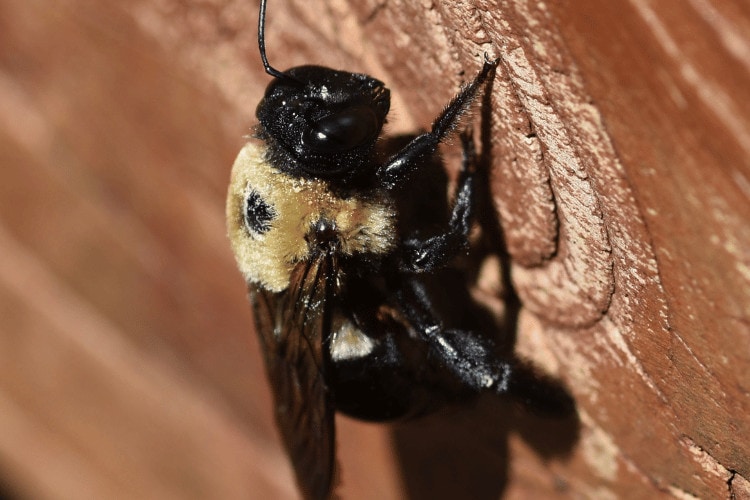Why Do Carpenter Bees Stare at You?
If you’ve ever found yourself face-to-face with nature’s architect, the carpenter bee, chances are you’ve noticed an intriguing behavior; the bee seems to be staring right at you.
For beekeepers and those fascinated by these buzzing creatures, this odd behavior can raise a few questions. One of these questions is, why do carpenter bees stare at you?
In this article, we’ll delve into the world of carpenter bees and uncover the reasons behind their curious habit of seemingly locking eyes with you. Stick around!
Getting to Know Carpenter Bees

Carpenter bees are fascinating insects belonging to the Xylocopinae subfamily.
These bees are known for their robust appearance, with the females boasting a distinctive and somewhat intimidating feature: a shiny, black, hairy abdomen. Their larger size and impressive flying skills often grab our attention as enthusiasts.
Carpenter bees are different from their more social honeybee relatives. While honeybees are all about teamwork, carpenter bees are solitary, focusing mainly on creating nests and raising their brood rather than working together in hives.
Reasons Why Carpenter Bees Stare
So, what’s up with the whole staring thing? Why do carpenter bees keep staring at you, as well as on other things? Below are some of the most notable reasons.
1. Surveying Their Nests
Carpenter bees, particularly female bees, have an uncanny ability to recognize suitable nesting sites. When they seem to be locking eyes with you, they’re actually assessing your presence in relation to their chosen environment.
Female carpenter bees seek out wooden structures that offer optimal conditions for their nesting habits and needs, such as fascia boards, tunnels in wood, and even outdoor furniture.
Their steady gaze is simply their way of examining these structures and trying to gauge if they meet the criteria for a safe and comfortable nest.
2. Assessing Wood Condition
Wood plays a pivotal role in the life of a carpenter bee. Beyond merely looking for a place to lay eggs, these bees are meticulous in their selection of the right kind of wood.
They’re drawn to dead wood and weathered wood surfaces, which provide the ideal texture and integrity for their carpenter bee nests.
When a carpenter bee stares at a piece of wood, which can sometimes be your furniture, the bee is basically engrossed in scrutinizing the wood’s condition, ensuring it’s the best possible substrate for nurturing its offspring.

3. Defensive Behavior
Carpenter bees, though generally not aggressive, can exhibit defensive behavior if they sense danger. This behavior is particularly noticeable when they’re around their chosen nesting spots.
If you find a carpenter bee seemingly fixated on you, it could be sizing you up to determine if you’re a potential threat. This defensive assessment is a key aspect of their survival strategy.
4. Curiosity About Beekeepers
Carpenter bees are incredibly perceptive creatures. If you’re a beekeeper or an aspiring one, your presence and activities around their potential nesting sites might pique their curiosity.
They could be observing your movements to understand whether or not you pose a threat to their nesting spots.
Additionally, maybe they’re fond of the color of your clothes. After all, bees tend to see colors much faster than humans.
It’s also worth noting that bees are attracted to certain scents. So, wearing certain perfumes or using certain shampoos can attract carpenter bees.
5. Marking Territories
While carpenter bees are solitary by nature, they still establish territories that they defend with surprising vigor. When they seem to be locking eyes with you or maybe with another bee, they might actually be marking their territory.
This non-aggressive stance serves as a visual warning to others. It serves as a signal that the area is claimed and should be respected.
It’s a way of maintaining a balance between individual space and community living.
6. Assessing Food Sources
While not as adept as honeybees, carpenter bees are still pollinators. Sometimes, their focused gaze is directed at flowering plants and potential food sources.
They meticulously inspect flowers, using their keen senses to assess the quality and quantity of nectar and pollen.
This behavior is simply their way of ensuring they gather the best nutrition for themselves and their developing brood.

7. Recognizing Familiar Faces
Believe it or not, carpenter bees have the ability to recognize specific individuals. If you’re a frequent visitor to their nesting sites or the areas they frequent, they might be engaging in a form of visual recognition.
This skill is particularly important when it comes to identifying potential threats versus familiar presences.
8. Bee Communication
The staring behavior of carpenter bees can be a means of communication among themselves. While carpenter bees don’t exhibit the complex social structures of honeybees, they engage in interactions that involve visual cues.
A carpenter bee’s gaze might convey messages about the availability of food, potential threats, or even the location of suitable nesting sites.
Wrapping Up
The act of carpenter bees seemingly staring at you, as well as other parts of their surroundings, is just one facet of their multifaceted behavior.
Beyond their interactions with beekeepers and enthusiasts, these insects engage in a spectrum of behaviors that reflect their intricate adaptation to their environment.
From territorial markings and assessing wood conditions to surveying their nests and evaluating food sources, their stares are a canvas on which their various interactions are painted.
As you observe these captivating creatures, remember that every gaze is a glimpse into their world, a silent language of communication that adds depth to our understanding of their lives.
